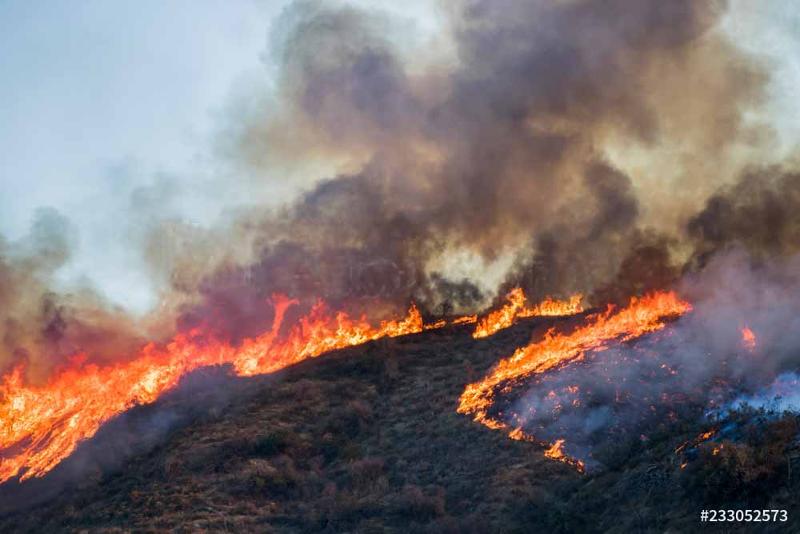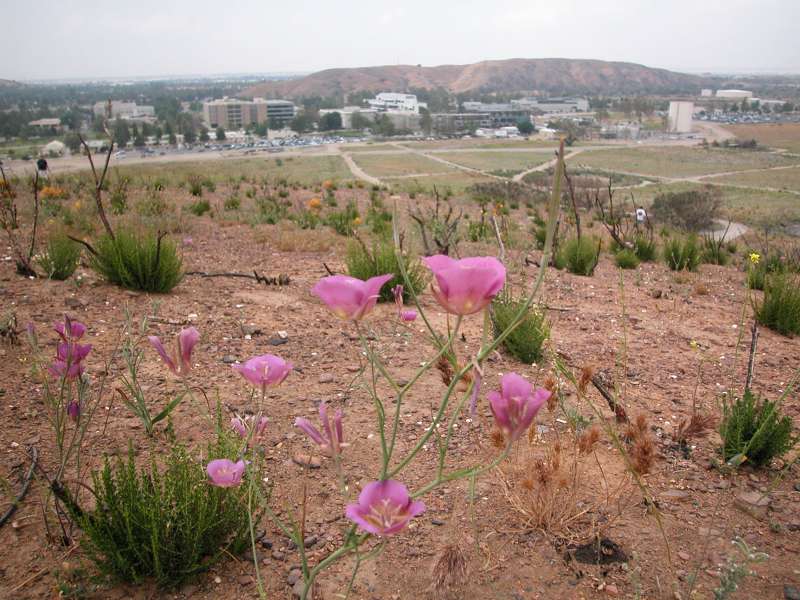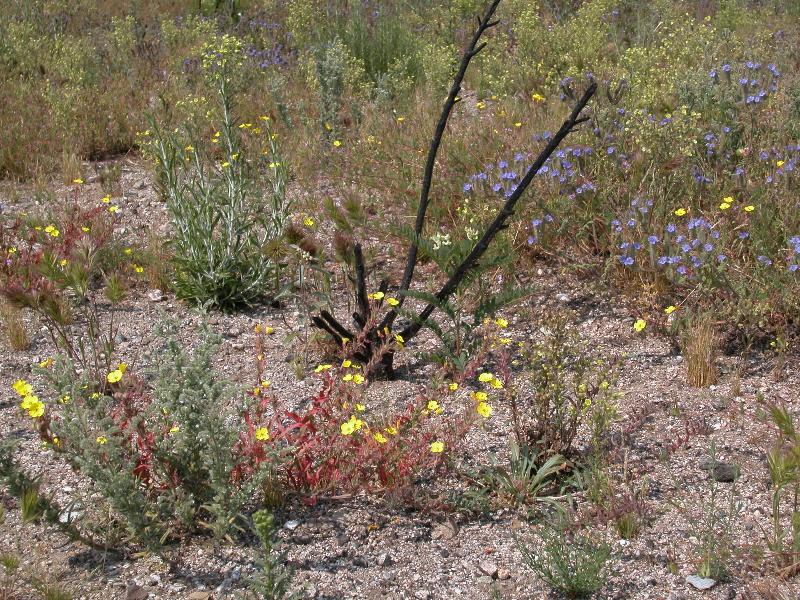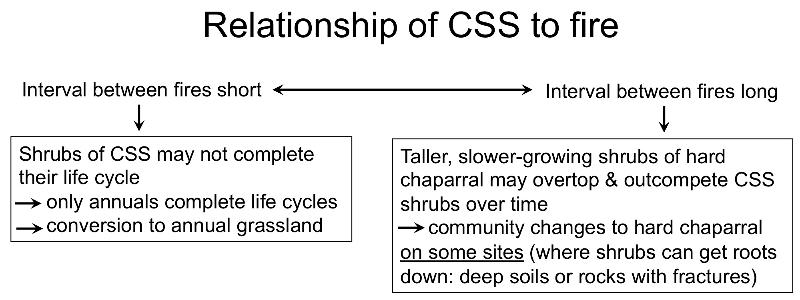 You were introduced to plant responses to fire in the "Plant Adaptations" lesson (Week 6). You also learned that different plant communities have very different histories of exposure to fire and that their dominant species differ in fire-tolerance.
You were introduced to plant responses to fire in the "Plant Adaptations" lesson (Week 6). You also learned that different plant communities have very different histories of exposure to fire and that their dominant species differ in fire-tolerance.Fire Effects on Plant Communities
 You were introduced to plant responses to fire in the "Plant Adaptations" lesson (Week 6). You also learned that different plant communities have very different histories of exposure to fire and that their dominant species differ in fire-tolerance.
You were introduced to plant responses to fire in the "Plant Adaptations" lesson (Week 6). You also learned that different plant communities have very different histories of exposure to fire and that their dominant species differ in fire-tolerance.
Understanding effects of fire is important in California for both safety and conservation reasons.
From a safety standpoint...
From a conservation standpoint...
Human influence on fire regimes have been long and varied. Humans set fire, both intentionally and by accident. They also try to put fires out. Prior to human colonization of California (13,000-15,000 years ago), humans did not influence the fire regime (of course). By the time Europeans made first contact in the 1500s, indigenous tribes (the first human colonists) were deliberately burning vegetation yearly (although it is not known whether they burned the same site yearly). In the early 1900s, as the European population of the state grew, fire suppression efforts became popular. Then, as forests became more dense, posing dangers of more catastrophic fires, prescribed fires were promoted to simulate the pre-1900 fire regime and keep forests more open.
Fire is often used as a management tool. However, different plants and plant communities react differently to fire and different fire regimes. To achieve a goal (e.g., reduction in fire frequency, reduction in fire intensity, reduction in mudslide hazard, conservation of rare plants and animals, etc.) by manipulating a fire regime, one needs to know the responses of the species in the system.
...and that is the long introduction about why you need to learn this stuff.
Some species have characteristics that allow a plant to survive fire.
Other species do not have individuals that survive fire, but the population regenerates from a soil seed bank. In this case, the plants do not survive, but the population persists on the site. (It is not extirpated.)
|
From your previous lesson: Plants that survive fire may... |
|
1) Resprout from belowground organs like a root crown (where the root meets the stem) or a rhizome (an underground, horizontal stem). Not all plants can do this. They have to have buds below ground that can start growing to produce a new stem, and they have to have sufficient storage reserves (starch) below ground to provide energy to produce the new stems and to keep the root alive while the stem is growing. 2) Have a life cycle that typically involves dying down to the ground each year and producing a new shoot from belowground roots, bulbs, corms, etc. These types of plants are typically dormant during late summer, when most fires occur anyway, with only the belowground parts alive. These belowground parts are protected from heat by the insulating properties of dry soil. 3) For a tree: have thick, insulating bark that protects the vascular cambium (the cell layer right under the bark that produces new xylem and phloem). If the tree is tall enough that its crown (the live branches and leaves) does not burn up in the fire, protecting the cambium will insure that the tree can continue to produce new xylem, to get water to the leaves, and new phloem, to get sugars to the roots, after the fire.
|
Note that when we talk about resprouting, we are talking about an individual plant that survives a fire putting up new shoots. We are not talking about seeds germinating.

|
From your previous lesson: If the plants do not survive fire, their populations may still persist on the site if they... |
|
4) Have an annual life cycle. Again, these plants are often dead by the time most fires occur in southern California, and seeds in the soil germinate, as usual, with the next rains. 5) Have seeds that are stimulated to germinate by either heat or chemicals in smoke. This causes seeds to germinate in the 1-2 years after a fire, when competition from other plants is low and conditions are good for seedling survival. Species that have seeds with these types of germination requirements often build up soil seed banks over years, producing seeds every year that do not germinate, but are added to the soil seed bank (a collection of dormant seeds in the soil). After a fire, fire-stimulated germination will deplete the soil seed bank (because the seeds germinated), and germination after subsequent fires will depend on whether the species has managed to replenish the soil seed bank since the last fire. 6) Have cones that open to release seeds after fire. Conifers (pines and relatives) that do this typically hold cones on their branches for years. Seeds are released when fires come through. Not all conifers do this. |


Read the first four pages of the excerpt from Halsey (2005) that is provided here (3.5 MB). (If you need a smaller copy, you can access a 215 kB copy, but the resolution is poor.) This is an excerpt from a book that was written for the general public. After you have read the entire first four pages, answer the questions below.
Skim the next 3 pages (pages 22-24) of Halsey (2005).
Read the last two pages of the excerpt from Halsey (2005).
|
From your previous lesson (Week 11): |
|
Although chaparral vegetation is adapted to fire, fires that are too frequent can eliminate chaparral species. If a resprouting species is reburned 1-2 years after a fire, it may be unable to resprout again: it depletes its starch reserves in the root by producing new shoots after the first fire, then does not have time to build up enough starch reserves between fires to successfully resprout again. If an "obligate seeder" is burned, it will be eliminated from a site if a second fire occurs before the plants germinate, grow, mature and set seed. An obligate seeder is a species that dies in a fire and has seeds in a soil seed bank that are stimulated to germinate by smoke or heat. A fire will kill existing plants and stimulate germination. The germination will deplete the soil seed bank. No new seeds will be added to the soil seed bank until the seedlings grow into mature plants that flower and produce seeds. The species that are most vulnerable to a short fire-return interval (time between fires) are the obligate seeders that grow slowly and take many years to reach maturity and produce many seeds.
Most chaparral species can persist in areas where fire occurs once every 20-80 years. Some species can tolerate more frequent fires, but not all species. |
Life history traits, together with fire adaptations, determine which plant species can persist on a site with a specific fire-free interval (years between fires).
Pertinent life history traits include:
Fire-responses that are not generally considered life-history traits, but are pertinent to population persistence under different fire regimes include:
The dominant species of different vegetation types (e.g., chaparral, CSS, and annual grassland) differ dramatically in their life history traits. In some cases, this simply leads to successional changes after fire. Where species of both CSS and hard chaparral exist on a site, the CSS subshrubs may dominate the site for a few years, being outcompeted as time goes on by the slower-growing, but taller, hard chaparral dominants.
|
From your previous lesson (Week 11) |
|
Dominant shrubs of coastal sage scrub include members of the mint family (black sage, white sage, purple sage, etc.) and California sagebrush. They tend to be shorter than shrubs of hard chaparral and mature more quickly, most maturing within four years. Therefore, although most of these shrubs are killed by fire, they can complete their life cycle in just a few years, and withstand more frequent fires than many species of hard chaparral. Fires that occur more frequently than once every four years, however, will tend to eliminate these shrubs, converting the site to an annual grassland. |
These processes are summarized in the graphic below.

Once the vegetation on a site has been converted to annual grassland in Southern California, its return to other vegetation types is usually slow or non-existent. These sites have undergone "type conversion" to annual grassland.
Check your understanding: